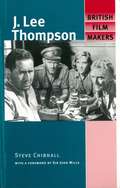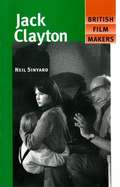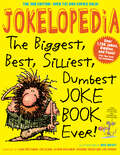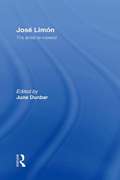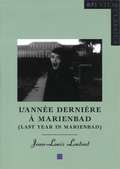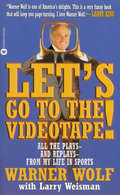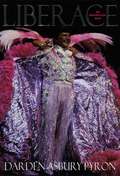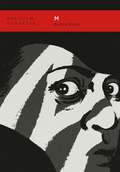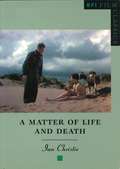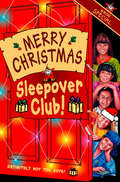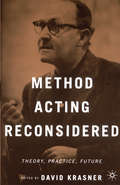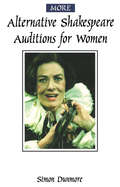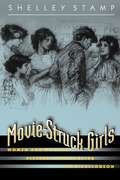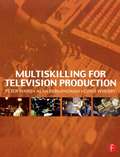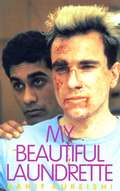- Table View
- List View
J. Lee Thompson (British Film-Makers)
by Steve ChibnallFirst published on the fiftieth anniversary of his directorial debut, this book was the first to examine the work of a man once hailed as the finest film-maker to emerge from the British studio system after the Second World War. Before being recruited by Hollywood, J. Lee Thompson made a string of classic films including: Yield to the Night (1956), Ice Cold in Alex (1958), Tiger Bay (1959), North West Frontier (1959) and The Guns of Navarone (1961). He worked in the Hollywood industry into his late eighties, making nearly thirty films as a director and producer between 1960 and 1990. He remains best known, however, for his first: the immortal thriller Cape Fear (1962). Drawing on extensive interview material, Steve Chibnall traces Lee Thompson's career in British cinema, and offers an analysis of his films which reveals remarkable, and previously unacknowledged, continuities of style and theme. This is a book for anyone interested in the history of British cinema, and particularly those who enjoy the best of 1950s and 1960s film.
Jack Clayton (British Film-Makers)
by Neil SinyardIn François Truffaut’s opinion The Innocents was ‘the best English film after Hitchcock goes to America’. Tennessee Williams said of The Great Gatsby: ‘a film whose artistry even surpassed the original novel’. The maker of both films was Jack Clayton, one of the finest English directors of the post-war era and perhaps best remembered for the trail-blazing Room at the Top which brought a new sexual frankness and social realism to the British screen. This is the first full-length critical study of Clayton's work. The author has been able to consult and quote from the director's own private papers which illuminate Clayton’s creative practices and artistic intentions. In addition to fresh analyses of the individual films, the book contains new material on Clayton's many unrealised projects and valuably includes his previously unpublished short story ‘The Enchantment’ – as poignant and revealing as the films themselves. This is a personal and fascinating account of the career and achievement of an important, much-loved director that should appeal to students and film enthusiasts.
Jean Renoir (French Film Directors Series)
by Martin O'ShaughnessyAccessible and original analysis of all Jean Renoir's sound films, including those he made in Hollywood - this is the first major study to appear for a number of years and brings new light on some of the director's most celebrated films.. Illuminating account of critical debates concerning Renoir, and focusing on hitherto neglected areas such as gender, nation and ethnicity the book asks us to rethink our understanding of Renoir's political commitment.. Traces his output from the silent period to the age of television, tying his work into a fast-shifting, socio-historical context.. Detailed analyses of his sound films map his evolving style while individual chapters cover Renoir's career and writings, critical debates, the silent and early sound films, the Popular Front period, Renoir amèricain and the later films.
Jokelopedia: The Biggest, Best, Silliest, Dumbest Joke Book Ever!
by Eva Blank Alison Benjamin Rosanne Green Ilana Weitzman Lisa SparksIt&’s the mother of all kids&’ joke books—an all-encompassing, gut-busting, and bestselling collection of more than 1,700 jokes, tongue-twisters, riddles, and puns for all occasions. Here are 61 elephant jokes, including: What did the elephant say when he walked into the post office? / Ouch! Dozens of knock-knock jokes, like: Knock-knock. / Who&’s there? / Doris. / Doris who? / Doris locked. That&’s why I knocked! Plus teacher jokes and creature jokes, doctor jokes and robber jokes, food jokes, gross jokes, why-did-the-chicken-cross-the-road jokes, and name-game jokes: What do you call a man in a tiger&’s cage? / Claude. And for all aspiring comedians, there are joke-telling pointers and tips, funny facts, and spotlights on comic TV shows, books, and actors, from Steve Carell to Tina Fey to SpongeBob Squarepants. It&’s the ultimate gift for the incurable jokester.
Jose Limon: An Artist Re-viewed (Choreography and Dance Studies Series)
by June DunbarJose Limn is universally recognized as one of the most important modern dancers of the 20th century. His technique is still taught at major colleges and dance schools; his dance company continues to revive his works, plus presents new works. His most famous work, The Moor's Pavanne, has been presented around the world by ballet and modern dance companies. This book presents a series of essays about Limn's life and works by noted scholars and dancers who were associated with Limn. It serves as a perfect introduction to his choreography and legacy. The book should appeal to fans of modern dance.
Jose Limon: An Artist Re-viewed (Choreography and Dance Studies Series)
by June DunbarJose Limn is universally recognized as one of the most important modern dancers of the 20th century. His technique is still taught at major colleges and dance schools; his dance company continues to revive his works, plus presents new works. His most famous work, The Moor's Pavanne, has been presented around the world by ballet and modern dance companies. This book presents a series of essays about Limn's life and works by noted scholars and dancers who were associated with Limn. It serves as a perfect introduction to his choreography and legacy. The book should appeal to fans of modern dance.
L'Année dernière à Marienbad (BFI Film Classics)
by Jean-Louis LeutratA quintessential work of 1960s European art cinema, L'Année dernière à Marienbad (Last Year in Marienbad, 1961) was a collaboration between director Alain Resnais and 'New Novel' enfant terrible Alain Robbe-Grillet. Three people, known only by their initials, move through the sprawling luxury of a mysterious hotel and its ornamental gardens. Perhaps M is A's husband and X her lover. Perhaps, 'last year', A promised X she would leave with him. Or is there something more terrible in the past? An abstract thriller, a love story, a philosophical puzzle, 'the film's deviations are', for Jean-Louis Leutrat, 'as complex as those of the human heart'.
Let's Go to the Videotape: All the Plays and Replays from My Life in Sports
by Larry Weisman Warner WolfAnyone who follows sports knows that Warner Wolf has revolutionized that world with his famous catch phrases and irrepressible spirit. Now, in "Let's Go to the Videotape!" he shares over three decades worth of humorous and unusual anecdotes from a fascinating career, including: -- opinions on sports rules -- game strategies that make no sense -- run-ins with the stars of sports and Hollywood -- including Shaquille O'Neal, Joe DiMaggio, Robert Redford, and Robert Duvall -- adventures and misadventures in the sports broadcasting game -- and much more.
Liberace: An American Boy
by Darden Asbury PyronMore people watched his nationally syndicated television show between 1953 and 1955 than followed I Love Lucy. Even a decade after his death, the attendance records he set at Madison Square Garden, the Hollywood Bowl, and Radio City Music Hall still stand. Arguably the most popular entertainer of the twentieth century, this very public figure nonetheless kept more than a few secrets. Darden Asbury Pyron, author of the acclaimed and bestselling Southern Daughter: The Life of Margaret Mitchell, leads us through the life of America's foremost showman with his fresh, provocative, and definitive portrait of Liberace, an American boy. Liberace's career follows the trajectory of the classic American dream. Born in the Midwest to Polish-Italian immigrant parents, he was a child prodigy who, by the age of twenty, had performed with the Chicago Symphony Orchestra. Abandoning the concert stage for the lucrative and glittery world of nightclubs, celebrities, and television, Liberace became America's most popular entertainer. While wildly successful and good natured outwardly, Liberace, Pyron reveals, was a complicated man whose political, social, and religious conservativism existed side-by-side with a lifetime of secretive homosexuality. Even so, his swishy persona belied an inner life of ferocious aggression and ambition. Pyron relates this private man to his public persona and places this remarkable life in the rapidly changing cultural landscape of twentieth-century America. Pyron presents Liberace's life as a metaphor, for both good and ill, of American culture, with its shopping malls and insatiable hunger for celebrity. In this fascinating biography, Pyron complicates and celebrates our image of the man for whom the streets were paved with gold lamé. "An entertaining and rewarding biography of the pianist and entertainer whose fans' adoration was equaled only by his critics' loathing. . . . [Pyron] persuasively argues that Liberace, thoroughly and rigorously trained, was a genuine musician as well as a brilliant showman. . . . [A]n immensely entertaining story that should be fascinating and pleasurable to anyone with an interest in American popular culture."—Kirkus Reviews "This is a wonderful book, what biography ought to be and so seldom is."—Kathryn Hughes, Daily Telegraph "[A]bsorbing and insightful. . . . Pyron's interests are far-ranging and illuminating-from the influence of a Roman Catholic sensibility on Liberace and gay culture to the aesthetics of television and the social importance of self-improvement books in the 1950s. Finally, he achieves what many readers might consider impossible: a persuasive case for Liberace's life and times as the embodiment of an important cultural moment."—Publishers Weekly "Liberace, coming on top of his amazing life of Margaret Mitchell, Southern Daughter, puts Darden Pyron in the very first rank of American biographers. His books are as exciting as the lives of his subjects."—Tom Wolfe "Fascinating, thoughtful, exhaustive, and well-written, this book will serve as the standard biography of a complex icon of American popular culture."—Library Journal
Liberace: An American Boy
by Darden Asbury PyronMore people watched his nationally syndicated television show between 1953 and 1955 than followed I Love Lucy. Even a decade after his death, the attendance records he set at Madison Square Garden, the Hollywood Bowl, and Radio City Music Hall still stand. Arguably the most popular entertainer of the twentieth century, this very public figure nonetheless kept more than a few secrets. Darden Asbury Pyron, author of the acclaimed and bestselling Southern Daughter: The Life of Margaret Mitchell, leads us through the life of America's foremost showman with his fresh, provocative, and definitive portrait of Liberace, an American boy. Liberace's career follows the trajectory of the classic American dream. Born in the Midwest to Polish-Italian immigrant parents, he was a child prodigy who, by the age of twenty, had performed with the Chicago Symphony Orchestra. Abandoning the concert stage for the lucrative and glittery world of nightclubs, celebrities, and television, Liberace became America's most popular entertainer. While wildly successful and good natured outwardly, Liberace, Pyron reveals, was a complicated man whose political, social, and religious conservativism existed side-by-side with a lifetime of secretive homosexuality. Even so, his swishy persona belied an inner life of ferocious aggression and ambition. Pyron relates this private man to his public persona and places this remarkable life in the rapidly changing cultural landscape of twentieth-century America. Pyron presents Liberace's life as a metaphor, for both good and ill, of American culture, with its shopping malls and insatiable hunger for celebrity. In this fascinating biography, Pyron complicates and celebrates our image of the man for whom the streets were paved with gold lamé. "An entertaining and rewarding biography of the pianist and entertainer whose fans' adoration was equaled only by his critics' loathing. . . . [Pyron] persuasively argues that Liberace, thoroughly and rigorously trained, was a genuine musician as well as a brilliant showman. . . . [A]n immensely entertaining story that should be fascinating and pleasurable to anyone with an interest in American popular culture."—Kirkus Reviews "This is a wonderful book, what biography ought to be and so seldom is."—Kathryn Hughes, Daily Telegraph "[A]bsorbing and insightful. . . . Pyron's interests are far-ranging and illuminating-from the influence of a Roman Catholic sensibility on Liberace and gay culture to the aesthetics of television and the social importance of self-improvement books in the 1950s. Finally, he achieves what many readers might consider impossible: a persuasive case for Liberace's life and times as the embodiment of an important cultural moment."—Publishers Weekly "Liberace, coming on top of his amazing life of Margaret Mitchell, Southern Daughter, puts Darden Pyron in the very first rank of American biographers. His books are as exciting as the lives of his subjects."—Tom Wolfe "Fascinating, thoughtful, exhaustive, and well-written, this book will serve as the standard biography of a complex icon of American popular culture."—Library Journal
Liberace: An American Boy
by Darden Asbury PyronMore people watched his nationally syndicated television show between 1953 and 1955 than followed I Love Lucy. Even a decade after his death, the attendance records he set at Madison Square Garden, the Hollywood Bowl, and Radio City Music Hall still stand. Arguably the most popular entertainer of the twentieth century, this very public figure nonetheless kept more than a few secrets. Darden Asbury Pyron, author of the acclaimed and bestselling Southern Daughter: The Life of Margaret Mitchell, leads us through the life of America's foremost showman with his fresh, provocative, and definitive portrait of Liberace, an American boy. Liberace's career follows the trajectory of the classic American dream. Born in the Midwest to Polish-Italian immigrant parents, he was a child prodigy who, by the age of twenty, had performed with the Chicago Symphony Orchestra. Abandoning the concert stage for the lucrative and glittery world of nightclubs, celebrities, and television, Liberace became America's most popular entertainer. While wildly successful and good natured outwardly, Liberace, Pyron reveals, was a complicated man whose political, social, and religious conservativism existed side-by-side with a lifetime of secretive homosexuality. Even so, his swishy persona belied an inner life of ferocious aggression and ambition. Pyron relates this private man to his public persona and places this remarkable life in the rapidly changing cultural landscape of twentieth-century America. Pyron presents Liberace's life as a metaphor, for both good and ill, of American culture, with its shopping malls and insatiable hunger for celebrity. In this fascinating biography, Pyron complicates and celebrates our image of the man for whom the streets were paved with gold lamé. "An entertaining and rewarding biography of the pianist and entertainer whose fans' adoration was equaled only by his critics' loathing. . . . [Pyron] persuasively argues that Liberace, thoroughly and rigorously trained, was a genuine musician as well as a brilliant showman. . . . [A]n immensely entertaining story that should be fascinating and pleasurable to anyone with an interest in American popular culture."—Kirkus Reviews "This is a wonderful book, what biography ought to be and so seldom is."—Kathryn Hughes, Daily Telegraph "[A]bsorbing and insightful. . . . Pyron's interests are far-ranging and illuminating-from the influence of a Roman Catholic sensibility on Liberace and gay culture to the aesthetics of television and the social importance of self-improvement books in the 1950s. Finally, he achieves what many readers might consider impossible: a persuasive case for Liberace's life and times as the embodiment of an important cultural moment."—Publishers Weekly "Liberace, coming on top of his amazing life of Margaret Mitchell, Southern Daughter, puts Darden Pyron in the very first rank of American biographers. His books are as exciting as the lives of his subjects."—Tom Wolfe "Fascinating, thoughtful, exhaustive, and well-written, this book will serve as the standard biography of a complex icon of American popular culture."—Library Journal
Liberace: An American Boy
by Darden Asbury PyronMore people watched his nationally syndicated television show between 1953 and 1955 than followed I Love Lucy. Even a decade after his death, the attendance records he set at Madison Square Garden, the Hollywood Bowl, and Radio City Music Hall still stand. Arguably the most popular entertainer of the twentieth century, this very public figure nonetheless kept more than a few secrets. Darden Asbury Pyron, author of the acclaimed and bestselling Southern Daughter: The Life of Margaret Mitchell, leads us through the life of America's foremost showman with his fresh, provocative, and definitive portrait of Liberace, an American boy. Liberace's career follows the trajectory of the classic American dream. Born in the Midwest to Polish-Italian immigrant parents, he was a child prodigy who, by the age of twenty, had performed with the Chicago Symphony Orchestra. Abandoning the concert stage for the lucrative and glittery world of nightclubs, celebrities, and television, Liberace became America's most popular entertainer. While wildly successful and good natured outwardly, Liberace, Pyron reveals, was a complicated man whose political, social, and religious conservativism existed side-by-side with a lifetime of secretive homosexuality. Even so, his swishy persona belied an inner life of ferocious aggression and ambition. Pyron relates this private man to his public persona and places this remarkable life in the rapidly changing cultural landscape of twentieth-century America. Pyron presents Liberace's life as a metaphor, for both good and ill, of American culture, with its shopping malls and insatiable hunger for celebrity. In this fascinating biography, Pyron complicates and celebrates our image of the man for whom the streets were paved with gold lamé. "An entertaining and rewarding biography of the pianist and entertainer whose fans' adoration was equaled only by his critics' loathing. . . . [Pyron] persuasively argues that Liberace, thoroughly and rigorously trained, was a genuine musician as well as a brilliant showman. . . . [A]n immensely entertaining story that should be fascinating and pleasurable to anyone with an interest in American popular culture."—Kirkus Reviews "This is a wonderful book, what biography ought to be and so seldom is."—Kathryn Hughes, Daily Telegraph "[A]bsorbing and insightful. . . . Pyron's interests are far-ranging and illuminating-from the influence of a Roman Catholic sensibility on Liberace and gay culture to the aesthetics of television and the social importance of self-improvement books in the 1950s. Finally, he achieves what many readers might consider impossible: a persuasive case for Liberace's life and times as the embodiment of an important cultural moment."—Publishers Weekly "Liberace, coming on top of his amazing life of Margaret Mitchell, Southern Daughter, puts Darden Pyron in the very first rank of American biographers. His books are as exciting as the lives of his subjects."—Tom Wolfe "Fascinating, thoughtful, exhaustive, and well-written, this book will serve as the standard biography of a complex icon of American popular culture."—Library Journal
Liberace: An American Boy
by Darden Asbury PyronMore people watched his nationally syndicated television show between 1953 and 1955 than followed I Love Lucy. Even a decade after his death, the attendance records he set at Madison Square Garden, the Hollywood Bowl, and Radio City Music Hall still stand. Arguably the most popular entertainer of the twentieth century, this very public figure nonetheless kept more than a few secrets. Darden Asbury Pyron, author of the acclaimed and bestselling Southern Daughter: The Life of Margaret Mitchell, leads us through the life of America's foremost showman with his fresh, provocative, and definitive portrait of Liberace, an American boy. Liberace's career follows the trajectory of the classic American dream. Born in the Midwest to Polish-Italian immigrant parents, he was a child prodigy who, by the age of twenty, had performed with the Chicago Symphony Orchestra. Abandoning the concert stage for the lucrative and glittery world of nightclubs, celebrities, and television, Liberace became America's most popular entertainer. While wildly successful and good natured outwardly, Liberace, Pyron reveals, was a complicated man whose political, social, and religious conservativism existed side-by-side with a lifetime of secretive homosexuality. Even so, his swishy persona belied an inner life of ferocious aggression and ambition. Pyron relates this private man to his public persona and places this remarkable life in the rapidly changing cultural landscape of twentieth-century America. Pyron presents Liberace's life as a metaphor, for both good and ill, of American culture, with its shopping malls and insatiable hunger for celebrity. In this fascinating biography, Pyron complicates and celebrates our image of the man for whom the streets were paved with gold lamé. "An entertaining and rewarding biography of the pianist and entertainer whose fans' adoration was equaled only by his critics' loathing. . . . [Pyron] persuasively argues that Liberace, thoroughly and rigorously trained, was a genuine musician as well as a brilliant showman. . . . [A]n immensely entertaining story that should be fascinating and pleasurable to anyone with an interest in American popular culture."—Kirkus Reviews "This is a wonderful book, what biography ought to be and so seldom is."—Kathryn Hughes, Daily Telegraph "[A]bsorbing and insightful. . . . Pyron's interests are far-ranging and illuminating-from the influence of a Roman Catholic sensibility on Liberace and gay culture to the aesthetics of television and the social importance of self-improvement books in the 1950s. Finally, he achieves what many readers might consider impossible: a persuasive case for Liberace's life and times as the embodiment of an important cultural moment."—Publishers Weekly "Liberace, coming on top of his amazing life of Margaret Mitchell, Southern Daughter, puts Darden Pyron in the very first rank of American biographers. His books are as exciting as the lives of his subjects."—Tom Wolfe "Fascinating, thoughtful, exhaustive, and well-written, this book will serve as the standard biography of a complex icon of American popular culture."—Library Journal
Liberace: An American Boy
by Darden Asbury PyronMore people watched his nationally syndicated television show between 1953 and 1955 than followed I Love Lucy. Even a decade after his death, the attendance records he set at Madison Square Garden, the Hollywood Bowl, and Radio City Music Hall still stand. Arguably the most popular entertainer of the twentieth century, this very public figure nonetheless kept more than a few secrets. Darden Asbury Pyron, author of the acclaimed and bestselling Southern Daughter: The Life of Margaret Mitchell, leads us through the life of America's foremost showman with his fresh, provocative, and definitive portrait of Liberace, an American boy. Liberace's career follows the trajectory of the classic American dream. Born in the Midwest to Polish-Italian immigrant parents, he was a child prodigy who, by the age of twenty, had performed with the Chicago Symphony Orchestra. Abandoning the concert stage for the lucrative and glittery world of nightclubs, celebrities, and television, Liberace became America's most popular entertainer. While wildly successful and good natured outwardly, Liberace, Pyron reveals, was a complicated man whose political, social, and religious conservativism existed side-by-side with a lifetime of secretive homosexuality. Even so, his swishy persona belied an inner life of ferocious aggression and ambition. Pyron relates this private man to his public persona and places this remarkable life in the rapidly changing cultural landscape of twentieth-century America. Pyron presents Liberace's life as a metaphor, for both good and ill, of American culture, with its shopping malls and insatiable hunger for celebrity. In this fascinating biography, Pyron complicates and celebrates our image of the man for whom the streets were paved with gold lamé. "An entertaining and rewarding biography of the pianist and entertainer whose fans' adoration was equaled only by his critics' loathing. . . . [Pyron] persuasively argues that Liberace, thoroughly and rigorously trained, was a genuine musician as well as a brilliant showman. . . . [A]n immensely entertaining story that should be fascinating and pleasurable to anyone with an interest in American popular culture."—Kirkus Reviews "This is a wonderful book, what biography ought to be and so seldom is."—Kathryn Hughes, Daily Telegraph "[A]bsorbing and insightful. . . . Pyron's interests are far-ranging and illuminating-from the influence of a Roman Catholic sensibility on Liberace and gay culture to the aesthetics of television and the social importance of self-improvement books in the 1950s. Finally, he achieves what many readers might consider impossible: a persuasive case for Liberace's life and times as the embodiment of an important cultural moment."—Publishers Weekly "Liberace, coming on top of his amazing life of Margaret Mitchell, Southern Daughter, puts Darden Pyron in the very first rank of American biographers. His books are as exciting as the lives of his subjects."—Tom Wolfe "Fascinating, thoughtful, exhaustive, and well-written, this book will serve as the standard biography of a complex icon of American popular culture."—Library Journal
M (BFI Film Classics)
by Anton KaesFritz Lang's 'M' (1931) is an undisputed classic of world cinema. Lang considered it his most lasting work. Peter Lorre's extraordinary performance as the childlike misfit Hans Beckert was one of the most striking of film debuts, and it made him an international star. Lang's vision of a city gripped with fear, haunted by surveillance and total mobillization, is still remarkably powerful today. And 'M' resonates too in the serial-killer genre which is so prominent in contemporary cinema. 'M' speaks to us as a timeless classic, but also as a Weimar film that has too often been isolated from its political and cultural context. In this groundbreaking book, Anton Kaes reconnects 'M''s much-studied formal brilliance to its significance as an event in 1931 Germany, recapturing the film's extraordinary social and symbolic energy. Interweaving close reading with cultural history, Kaes reconstitutes 'M' as a crucial modernist artwork. In addition he analyzes Joseph Losey's 1951 film noir remake and, in an appendix, publishes for the first time 'M''s missing scene.
A Matter of Life and Death (BFI Film Classics)
by Ian ChristieA dazzling fantasy produced in the aftermath of World War Two, A Matter of Life and Death (1946), directed by Michael Powell and Emeric Pressburger, starred David Niven as an RAF pilot poised between life and death. This books looks in detail at the making of the film. Ian Christie shows how the film drew on many sources and traditions to create a unique form of modern masque, treating contemporary issues with witty allegory and enormous visual imagination. He believes the film deserves to be thought of as one of cinema's greatest achievement.
Merry Christmas, Sleepover Club: Christmas Special (The Sleepover Club #36)
by Sue MongredienJoin the Sleepover Club: Frankie, Kenny, Felicity, Rosie and Lyndsey, five girls who want to have fun – but who always end up in mischief!
Method Acting Reconsidered: Theory, Practice, Future
by NA NAMethod Acting is one of the most popular and controversial approaches to acting in the United States. It has not only shaped important schools of acting, but has been a fundamental constant of all American acting. This insightful volume explores Method Acting from a broad perspective, focusing on a point of equilibrium between the principles of the Method and its relationship to other theories of performance. David Krasner has gathered together some of the most well-known theater scholars and acting teachers to look at the Method. By concentrating on three areas of the Method - its theory, practice, and future application - the collection will serve to inform and teach us how to approach acting and acting theory in the 21st century.
More Alternative Shakespeare Auditions for Women
by Simon DunmoreFollowing on his successful Alternative Shakespeare Auditions for Women, Simon Dunmore presents even more underappreciated speeches that will make a classical audition sound fresh.
More Alternative Shakespeare Auditions for Women
by Simon DunmoreFollowing on his successful Alternative Shakespeare Auditions for Women, Simon Dunmore presents even more underappreciated speeches that will make a classical audition sound fresh.
Movie-Struck Girls: Women and Motion Picture Culture after the Nickelodeon
by Shelley StampMovie-Struck Girls examines women's films and filmgoing in the 1910s, a period when female patronage was energetically courted by the industry for the first time. By looking closely at how women were invited to participate in movie culture, the films they were offered, and the visual pleasures they enjoyed, Shelley Stamp demonstrates that women significantly complicated cinemagoing throughout this formative, transitional era. Growing female patronage and increased emphasis on women's subject matter did not necessarily bolster cinema's cultural legitimacy, as many in the industry had hoped, for women were not always enticed to the cinema by dignified, uplifting material, and once there, they were not always seamlessly integrated in the social space of theaters, nor the new optical pleasures of film viewing. In fact, Stamp argues that much about women's films and filmgoing in the postnickelodeon years challenged, rather than served, the industry's drive for greater respectability. White slave films, action-adventure serial dramas, and women's suffrage photoplays all drew female audiences to the cinema with stories aimed directly at women's interests and with advertising campaigns that specifically targeted female moviegoers. Yet these examples suggest that women's patronage was built with stories focused on sexuality, sensational thrill-seeking, and feminist agitation, topics not normally associated with ladylike gentility. And in each case concerns were raised about women's conduct at cinemas and the viewing habits they enjoyed, demonstrating that women's integration into motion picture culture was not as smooth as many have thought.
Movie-Struck Girls: Women and Motion Picture Culture after the Nickelodeon (PDF)
by Shelley StampMovie-Struck Girls examines women's films and filmgoing in the 1910s, a period when female patronage was energetically courted by the industry for the first time. By looking closely at how women were invited to participate in movie culture, the films they were offered, and the visual pleasures they enjoyed, Shelley Stamp demonstrates that women significantly complicated cinemagoing throughout this formative, transitional era. Growing female patronage and increased emphasis on women's subject matter did not necessarily bolster cinema's cultural legitimacy, as many in the industry had hoped, for women were not always enticed to the cinema by dignified, uplifting material, and once there, they were not always seamlessly integrated in the social space of theaters, nor the new optical pleasures of film viewing. In fact, Stamp argues that much about women's films and filmgoing in the postnickelodeon years challenged, rather than served, the industry's drive for greater respectability. White slave films, action-adventure serial dramas, and women's suffrage photoplays all drew female audiences to the cinema with stories aimed directly at women's interests and with advertising campaigns that specifically targeted female moviegoers. Yet these examples suggest that women's patronage was built with stories focused on sexuality, sensational thrill-seeking, and feminist agitation, topics not normally associated with ladylike gentility. And in each case concerns were raised about women's conduct at cinemas and the viewing habits they enjoyed, demonstrating that women's integration into motion picture culture was not as smooth as many have thought.
Multiskilling for Television Production
by Peter Ward Alan Bermingham Chris WherryWritten by television trainers who run their own courses on Multiskilling, this book offers a comprehensive introduction to the broad range of skills and technical knowledge required in this industry. It details all the essential information you need to know, acting as an on-the-job reference source for everyday use. For many broadcasting technicians, one of the biggest challenges in recent years has been the transition from a career working in a solo core skill such as camerawork or audio, to acquiring the experience and expertise of a range of production jobs. Many people are expected to work in a number of crafts and to equip themselves with a much wider range of television techniques than had been customary in the past.Multiskilling has become an integral part of television culture, requiring that new entrants are competent in several specialist production skills. Multiskilling for Television Production concentrates on the techniques associated with news and magazine programme production, where most tecnhical operators are usually employed, but most techniques are shared across the whole spectrum of television and film making.Anyone baffled by the range and scope of skills to be mastered will find this book invaluable.
Multiskilling for Television Production
by Peter Ward Alan Bermingham Chris WherryWritten by television trainers who run their own courses on Multiskilling, this book offers a comprehensive introduction to the broad range of skills and technical knowledge required in this industry. It details all the essential information you need to know, acting as an on-the-job reference source for everyday use. For many broadcasting technicians, one of the biggest challenges in recent years has been the transition from a career working in a solo core skill such as camerawork or audio, to acquiring the experience and expertise of a range of production jobs. Many people are expected to work in a number of crafts and to equip themselves with a much wider range of television techniques than had been customary in the past.Multiskilling has become an integral part of television culture, requiring that new entrants are competent in several specialist production skills. Multiskilling for Television Production concentrates on the techniques associated with news and magazine programme production, where most tecnhical operators are usually employed, but most techniques are shared across the whole spectrum of television and film making.Anyone baffled by the range and scope of skills to be mastered will find this book invaluable.
My Beautiful Laundrette: My Beautiful Laundrette; Sammy And Rosie Get Laid; London Kills Me; My Son The Fanatic
by Hanif KureishiOmar is a restless young Asian man, caring for his alcoholic father in the hustling London of the mid-1980s. His uncle, a keen Thatcherite, offers Omar an entrepreneurial opportunity to revamp a dingy laundrette, and ambitious Omar rolls up his sleeves, enlisting the assistance of his old school-friend Johnny, who has since fallen in with a gang of neo-fascists. Omar and Johnny soon form an unlikely alliance that leads to business success, as well as other, more intimate surprises.
